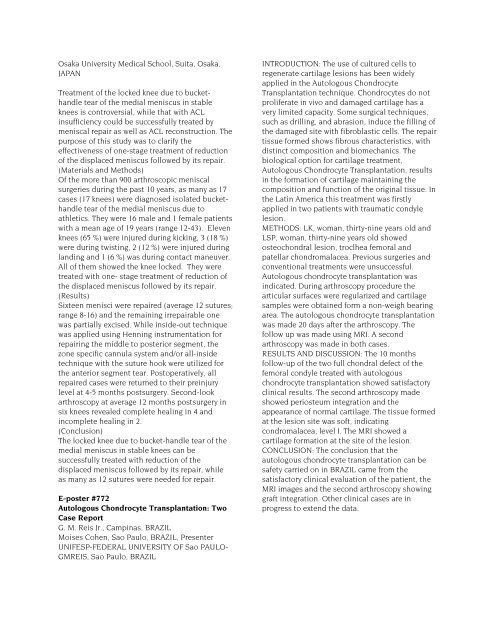POSTER ABSTRACTS - ISAKOS
POSTER ABSTRACTS - ISAKOS
POSTER ABSTRACTS - ISAKOS
Create successful ePaper yourself
Turn your PDF publications into a flip-book with our unique Google optimized e-Paper software.
Osaka University Medical School, Suita, Osaka,<br />
JAPAN<br />
Treatment of the locked knee due to buckethandle<br />
tear of the medial meniscus in stable<br />
knees is controversial, while that with ACL<br />
insufficiency could be successfully treated by<br />
meniscal repair as well as ACL reconstruction. The<br />
purpose of this study was to clarify the<br />
effectiveness of one-stage treatment of reduction<br />
of the displaced meniscus followed by its repair.<br />
(Materials and Methods)<br />
Of the more than 900 arthroscopic meniscal<br />
surgeries during the past 10 years, as many as 17<br />
cases (17 knees) were diagnosed isolated buckethandle<br />
tear of the medial meniscus due to<br />
athletics. They were 16 male and 1 female patients<br />
with a mean age of 19 years (range 12-43). Eleven<br />
knees (65 %) were injured during kicking, 3 (18 %)<br />
were during twisting, 2 (12 %) were injured during<br />
landing and 1 (6 %) was during contact maneuver.<br />
All of them showed the knee locked. They were<br />
treated with one- stage treatment of reduction of<br />
the displaced meniscus followed by its repair.<br />
(Results)<br />
Sixteen menisci were repaired (average 12 sutures;<br />
range 8-16) and the remaining irrepairable one<br />
was partially excised. While inside-out technique<br />
was applied using Henning instrumentation for<br />
repairing the middle to posterior segment, the<br />
zone specific cannula system and/or all-inside<br />
technique with the suture hook were utilized for<br />
the anterior segment tear. Postoperatively, all<br />
repaired cases were returned to their preinjury<br />
level at 4-5 months postsurgery. Second-look<br />
arthroscopy at average 12 months postsurgery in<br />
six knees revealed complete healing in 4 and<br />
incomplete healing in 2.<br />
(Conclusion)<br />
The locked knee due to bucket-handle tear of the<br />
medial meniscus in stable knees can be<br />
successfully treated with reduction of the<br />
displaced meniscus followed by its repair, while<br />
as many as 12 sutures were needed for repair.<br />
E-poster #772<br />
Autologous Chondrocyte Transplantation: Two<br />
Case Report<br />
G. M. Reis Jr., Campinas, BRAZIL<br />
Moises Cohen, Sao Paulo, BRAZIL, Presenter<br />
UNIFESP-FEDERAL UNIVERSITY OF Sao PAULO-<br />
GMREIS, Sao Paulo, BRAZIL<br />
INTRODUCTION: The use of cultured cells to<br />
regenerate cartilage lesions has been widely<br />
applied in the Autologous Chondrocyte<br />
Transplantation technique. Chondrocytes do not<br />
proliferate in vivo and damaged cartilage has a<br />
very limited capacity. Some surgical techniques,<br />
such as drilling, and abrasion, induce the filling of<br />
the damaged site with fibroblastic cells. The repair<br />
tissue formed shows fibrous characteristics, with<br />
distinct composition and biomechanics. The<br />
biological option for cartilage treatment,<br />
Autologous Chondrocyte Transplantation, results<br />
in the formation of cartilage maintaining the<br />
composition and function of the original tissue. In<br />
the Latin America this treatment was firstly<br />
applied in two patients with traumatic condyle<br />
lesion.<br />
METHODS: LK, woman, thirty-nine years old and<br />
LSP, woman, thirty-nine years old showed<br />
osteochondral lesion, troclhea femoral and<br />
patellar chondromalacea. Previous surgeries and<br />
conventional treatments were unsuccessful.<br />
Autologous chondrocyte transplantation was<br />
indicated. During arthroscopy procedure the<br />
articular surfaces were regularized and cartilage<br />
samples were obtained form a non-weigh bearing<br />
area. The autologous chondrocyte transplantation<br />
was made 20 days after the arthroscopy. The<br />
follow up was made using MRI. A second<br />
arthroscopy was made in both cases.<br />
RESULTS AND DISCUSSION: The 10 months<br />
follow-up of the two full chondral defect of the<br />
femoral condyle treated with autologous<br />
chondrocyte transplantation showed satisfactory<br />
clinical results. The second arthroscopy made<br />
showed periosteum integration and the<br />
appearance of normal cartilage. The tissue formed<br />
at the lesion site was soft, indicating<br />
condromalacea, level I. The MRI showed a<br />
cartilage formation at the site of the lesion.<br />
CONCLUSION: The conclusion that the<br />
autologous chondrocyte transplantation can be<br />
safety carried on in BRAZIL came from the<br />
satisfactory clinical evaluation of the patient, the<br />
MRI images and the second arthroscopy showing<br />
graft integration. Other clinical cases are in<br />
progress to extend the data.
















